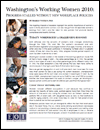More Washington women are primary breadwinners, but their economic progress has stalled out
This Sunday, thousands of moms will be recognized and appreciated for all they do. But when they go back to work on Monday, neither their wages nor the policies at their workplaces will fully reflect the contributions they make at work or at home.
EOI’s latest report, Washington’s Working Women 2010, notes the gulf separating men’s and women’s earnings has expanded over the past two decades. Women’s average monthly paychecks were just 63% of men’s in 2008, compared to 67% in 1990. And while benefits like paid sick days and paid family leave are critical for women, who are often the primary caregivers for children and elderly parents, 41% of Washington workers – 1.2 million people – can’t take a paid sick day at work.
Women have experienced fewer job losses since the start of the recession, but inequality on payday has persisted – with men earning substantially higher wages than women in every industry in Washington. And lower wages lead to higher rates of poverty among women, especially for mothers with young children.
Part of the issue is a lack of support for women – and families in general – in most workplaces, says Marilyn Watkins, Policy Director at the Economic Opportunity Institute and author of the report. Watkins points out that “the U.S. stands alone among economically developed nations in not providing universal paid leave for new parents and setting other minimum standards for paid leave. A paltry 8% of employees in the U.S. receive paid family leave from their employers, and 4 in 10 workers lack paid sick leave.”
For the vast majority of women, there is no slack in the work and family balance equation. The Family and Medical Leave Act passed in 1993 has helped some families balance their work and family obligations with 12 weeks of unpaid leave, but leaves more than 40% of workers unprotected, and does not cover routine illnesses and preventative care.
Women not only earn lower wages than their male counterparts – they are also less likely than men to receive benefits from their employers, and more likely to work part time or take breaks from employment for family care. According to the report, just over 37% of Washington’s working women are employed part-time, compared to 23.1% of men. But only 13% of Washington employers provide sick leave and retirement plans, and 20% offer vacation, to part time workers.
“Women will not make further gains without universally accessible paid sick leave, paid family leave, and workplace flexibility. Passing laws guaranteeing access to these workplace benefits will be necessary for women to achieve equality at work,” says Watkins.
Read more: Washington’s Working Women 2010
More To Read
April 17, 2024
2023-24 Impact and Gratitude Report
Reflecting on a year of progress and transition at EOI
April 12, 2024
Welcoming our New Executive Director, Rian Watt!
EOI is excited to begin its next chapter under new leadership
April 4, 2024
Is There a Valid Argument Against Cost-Free College in Washington?
Cost-free college is a meaningful investment that would change lives. What's stopping Washington from making it happen?

